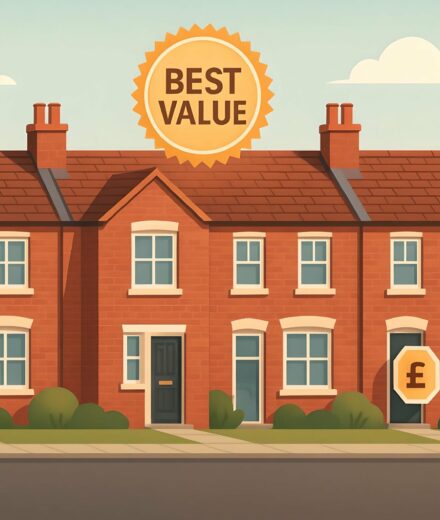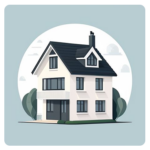

Unlock the UK Property Market
House Prices > Romford
| Year | Average Price | Transactions |
|---|---|---|
| 2025 (proj.) | £427,100 | 2,398 |
| 2024 | £414,400 | 1,717 |
| 2023 | £404,900 | 1,955 |
| 2022 | £409,000 | 2,543 |
| 2021 | £379,500 | 3,331 |
| 2020 | £367,100 | 2,124 |
| 2019 | £347,300 | 2,477 |
| 2018 | £347,000 | 2,639 |
Romford’s house prices have been on an unrelenting upward rise since 2018. In some years, prices have climbed faster than a cat up a tree in a thunderstorm, driven by sharply shifting buyer appetites and supply patterns.
This market feels neither sleepy nor out of control. Instead, it has a distinctly athletic tempo; prices sprint, but buyers now jog, side-stepping overvaluation and holding out for the right deal.
With these figures in mind, it might be time to ask: What’s Your Home Really Worth in Romford?
Romford’s story is one of momentum, recalibration and ambition. For some, buying here is a bit like chasing the last bus on a rainy evening - exhilarating but never easy.

Avg. Property Price: £616,100
Avg. Size of Property
1,333 sq/ft
Avg. Cost Per Sq/ft
£487 sq/ft
Total transactions
468 (since 2021)

Avg. Property Price: £473,600
Avg. Size of Property
1,041 sq/ft
Avg. Cost Per Sq/ft
£470 sq/ft
Total transactions
2,239 (since 2021)

Avg. Property Price: £371,000
Avg. Size of Property
863 sq/ft
Avg. Cost Per Sq/ft
£437 sq/ft
Total transactions
3,655 (since 2021)

Avg. Property Price: £252,200
Avg. Size of Property
577 sq/ft
Avg. Cost Per Sq/ft
£460 sq/ft
Total transactions
792 (since 2021)
Romford’s recent numbers paint a complicated, and at times bewildering, picture of property pricing across different types. While headlines trumpet rising demand and above-average sale figures, digging into the sizeable differences between property types raises several, rather prickly, questions for those considering a purchase. Detached properties still ask for a significant premium, but semi-detached and terraced homes see the lion’s share of recent transactions, hinting that buyers might be less willing to roll the dice on luxury and more inclined to seek value, location, or simply something they can actually afford.
Semi-detached homes are still the workhorses of Romford’s market. Their persistent popularity rings loud and clear, with thousands sold since 2021. These homes straddle that increasingly narrow line between aspiration and pragmatism. Their price per square foot is, quite strikingly, almost level with detached properties. That similarity prompts doubters to ask: is the extra chunk of garden or wider driveway worth the sizeable jump in the average sale price? For many, the answer remains uncertain. It feels less like “prime location” and more like a toss-up, with buyers forced to make peace with whatever corner of Romford they can secure.
Terraced housing, as ever, refuse to be sidelined. Commanding the highest transaction volume by quite a margin, these homes are abundant, practical, and still (just barely) within reach of many first-time buyers. But when you see their cost per square foot inching ever-closer to that of their semi-detached cousins, it raises a flag. Is Romford, for all its growth, now pricing even its modest terraces beyond the reach of the average local family? It is a development worth watching with a careful, perhaps even suspicious, eye.
With flats, things quickly grow more peculiar. The numbers imply a market in flux, almost anxious. Their average sale price is distinctly lower, but yield cost per square foot figures nearly as high as semi-detached and terraced homes. This feels counterintuitive. Buyers are evidently paying more for less space, fewer amenities, and, in many cases, less stability. Are flats truly “entry level” in Romford anymore, or just another risky bet stacked awkwardly against renters and first-timers?
And what of the detached outliers? Here, the higher cost per square foot and serious jump in average price feel expected, yes, but little in the statistics suggests buyers are getting exponentially more for their money - except perhaps a brag-worthy postal code. Romford’s priciest homes are being bought by those able, not those aspirational. It gives a sense of a market split by wage brackets, not lifestyle choices.
Romford is busy, competitive, and at times feels as chaotic as the Liberty at Friday’s closing time. While conventional wisdom says you cannot go wrong with bricks and mortar here, these figures whisper a subtler story. Ignore the bragging headlines, question the hype, and check your priorities before leaping. Sometimes, the “trend” makes for a risky gamble.
| District | Avg Price (£) | Transactions |
|---|---|---|
| RM1 | £376,600 | 2,869 |
| RM2 | £459,800 | 1,644 |
| RM3 | £361,400 | 4,253 |
| RM4 | £554,100 | 391 |
| RM5 | £381,100 | 1,866 |
| RM6 | £363,400 | 2,577 |
| RM7 | £358,200 | 3,337 |
Romford’s property prices are not just a single number you see splashed across estate agent windows. Instead, they’re a colourful patchwork, shifting distinctly between districts and bouncing around like a rubber ball in a small room. Common wisdom says “Romford is too expensive for young buyers” or “It’s all much the same across the borough.” We have to say, the data proves these ideas don’t always match reality.
At the upper end, one district is genuinely in a league of its own. If you’re eyeing up RM4, expect premium pricing and relatively rare sales. This postcode almost feels like Romford’s answer to Richmond, with prices putting clear blue water between it and the rest. Properties here tend to be larger, detached, and tightly-held, meaning that every transaction stands out against a backdrop of leafy privacy and quiet lanes.
Looking for livelier activity and a broader range of options? More affordable districts, such as RM3 and RM7, are buzzing with energy. These places show high transaction counts which, to us at M0VE, signals that buyers are still wheeling and dealing in Romford’s humbler postcodes. And the typical home here isn’t quite as eye-wateringly expensive – which should make first-timers and upsizers alike sit up and pay attention. Looking for savvy value? Check out Romford’s best-priced districts here.
For those who believe “it’s all about the station” – yes, areas a stone’s throw from Romford rail can fetch a premium, but don’t be fooled into thinking all nearby postcodes price you out. RM1 and RM2 bridge the gap, offering access to amenities, better transport, and a mix of traditional and modern homes. There’s much more variety than meets the eye.
Transactions in less headline-grabbing areas (like RM5 and RM6) may not hit the same heights, but they provide a steady mid-range alternative. These districts deliver homes that are neither at the sharpest end of the price spectrum, nor scraping the bottom. For many families, they remain the Goldilocks zone of Romford – neither too hot nor too cold, just right for those seeking an accessible step up or a straightforward move.
If you’re curious about your local market, or keen to know What’s Your Home Really Worth in Romford?, get straight-talking answers here.
Please note: these numbers are based solely on pricing averages and transaction volumes across Romford’s districts.
They do not factor in average size or cost per square foot, which could shift how trends appear. For a clearer district view, head over to our blog. Thank you.
| City | Avg Price (£) | Transactions |
|---|---|---|
| Hornchurch | £447,200 | 5,824 |
| Dagenham | £328,600 | 6,604 |
| Chigwell | £488,900 | 1,650 |
| Upminster | £533,700 | 2,303 |
| Rainham | £373,300 | 3,018 |
| Ilford | £444,500 | 8,017 |
| Barking | £342,100 | 2,920 |
| Brentwood | £430,300 | 5,101 |
| Loughton | £483,800 | 2,729 |
| Woodford Green | £541,200 | 2,512 |
The Romford market is as lively as a High Street on market day, drawing buyers from all walks of life. What stands out immediately is how Romford's prices slot in against its neighbours – it’s neither the priciest nor the cheapest, but hovers in a sweet spot that appeals to a broad spectrum of home seekers.
Commuter convenience and family amenities keep Romford's popularity ticking along steadily. If you look east or west, price differences become unmistakable.
Transaction volumes paint their own story. Ilford steals the show for sheer activity, with more sales than any neighbouring area. Romford, too, stays exceptionally busy, balancing access, price, and diversity of stock.
Romford’s market moves in mysterious ways, a bit like the Essex weather – never dull, always fluid, and packed with options for nearly every kind of buyer.
Please be aware that the following figures look only at headline averages for property prices and sales activity.
This data leaves out property sizes and square foot costs, so full trends might not be visible. See more detail at our blog. Thank you.
We bring clarity to complex property data, adjusting key figures until the results speak clearly - no exaggeration, no shortcuts. Learn how we keep things sharp
Our site uses cookies. By using this site, you agree to the Privacy Policy and Terms of Use.